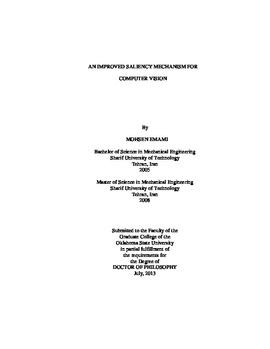| dc.contributor.advisor | Hoberock, Larry L. | |
| dc.contributor.author | Emami, Mohsen | |
| dc.date.accessioned | 2014-09-24T14:16:55Z | |
| dc.date.available | 2014-09-24T14:16:55Z | |
| dc.date.issued | 2013-07 | |
| dc.identifier.uri | https://hdl.handle.net/11244/11014 | |
| dc.description.abstract | The objective of this project is to find an efficient biologically plausible model for the bottom-up saliency mechanism of the human vision system (HVS) and employ it in computer vision applications. In practice, analyzing or storing all information entering the human eye at every moment is beyond the capabilities of the human neural system. The saliency mechanism controls the process of selecting and allocating attention to the most "prominent" locations in the scene, which are mostly referred to as "salient points" or "interesting points" in the literature. The same problem of information overload exists in most of the computer vision applications and an efficient visual saliency model can help reducing time consumption of the algorithm. These applications comprise, but are not limited to, automatic target detection, robotics and image and video compression. | |
| dc.description.abstract | In the report herein, the general architecture of models of the HVS saliency mechanism is presented and some of the well-known models are illustrated. There are several metrics to compare saliency models; however, results from different metrics vary widely in evaluating models. Since it is important to know which models perform the best in mimicking the saliency mechanism of the human visual system, first a procedure is proposed for evaluating metrics for comparing saliency maps using a database of human fixations on approximately 1000 images. This procedure is then employed to identify the best metric. This best metric is then used to evaluate nine published bottom-up saliency models on two databases, one containing natural images and the other synthetic ones. Furthermore, a new method for normalizing feature saliency maps in the saliency detection mechanisms is introduced. Also, the best visual saliency model in the literature is modified to overcome some deficiencies by automatically selecting different parameters for different regions of the image. As an application of the models of the saliency mechanisms, a saliency mechanism with the new normalization method is then applied to dishware inspection that shows interesting results. | |
| dc.format | application/pdf | |
| dc.language | en_US | |
| dc.rights | Copyright is held by the author who has granted the Oklahoma State University Library the non-exclusive right to share this material in its institutional repository. Contact Digital Library Services at lib-dls@okstate.edu or 405-744-9161 for the permission policy on the use, reproduction or distribution of this material. | |
| dc.title | Improved saliency mechanism for computer vision | |
| dc.contributor.committeeMember | Hanan, Jay | |
| dc.contributor.committeeMember | Young, Gary | |
| dc.contributor.committeeMember | Chandler, Damon | |
| osu.filename | Emami_okstate_0664D_12824.pdf | |
| osu.accesstype | Open Access | |
| dc.type.genre | Dissertation | |
| dc.type.material | Text | |
| dc.subject.keywords | bottom-up saliency mechanism | |
| dc.subject.keywords | top-down saliency | |
| dc.subject.keywords | computer vision applications | |
| dc.subject.keywords | human visual system | |
| dc.subject.keywords | automatic dish inspection | |
| thesis.degree.discipline | Mechanical Engineering | |
| thesis.degree.grantor | Oklahoma State University | |
